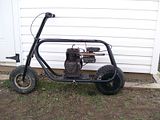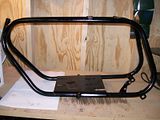This project mounted a real 8 ball into the mouth of a trumpet exhaust on a custom minibike. The 8 ball spins slowly as the engine idles, and speeds up as rpm increases.
Pic 1- The photos in this set came from fitting the 8 ball mounting bracketry to this Honda GC160 engine, but this project can be adapted to almost any engine, with minor alteration to the exhaust to form a trumpet at the end. This engine has a velocity stack and exhaust made from real brass and copper bugles, available at flea markets or Harbor Freight stores for about $15 each, or less.
Pic 2- The idea is to fabricate a mounting bracket sized and shaped to use exhaust gases flowing around the 8 ball, causing it to spin. I chose these bugles because the mouth opening is just the size I want to be able to place the ball into the opening and have it seen well from this angle, but...
Pic 3- the opening is also the right size to allow the ball to be seen protruding from this angle also.
Pic 4- I chose some fairly thick 1" wide brass stock to fabricate the bracket. The stock was held up to the mouth and marked for bending, and then hand-bent in the loose jaws of a bench vise. I wasn't worried about scratches at this point...they'll be removed later.
Pic 5- I bent the bracket a little at a time, adding additional marks for contours, and attempting to exactly conform to the inside of the exhaust while creating space to mount the 8 ball within the contours of the bracket.
Pic 1- The photos in this set came from fitting the 8 ball mounting bracketry to this Honda GC160 engine, but this project can be adapted to almost any engine, with minor alteration to the exhaust to form a trumpet at the end. This engine has a velocity stack and exhaust made from real brass and copper bugles, available at flea markets or Harbor Freight stores for about $15 each, or less.
Pic 2- The idea is to fabricate a mounting bracket sized and shaped to use exhaust gases flowing around the 8 ball, causing it to spin. I chose these bugles because the mouth opening is just the size I want to be able to place the ball into the opening and have it seen well from this angle, but...
Pic 3- the opening is also the right size to allow the ball to be seen protruding from this angle also.
Pic 4- I chose some fairly thick 1" wide brass stock to fabricate the bracket. The stock was held up to the mouth and marked for bending, and then hand-bent in the loose jaws of a bench vise. I wasn't worried about scratches at this point...they'll be removed later.
Pic 5- I bent the bracket a little at a time, adding additional marks for contours, and attempting to exactly conform to the inside of the exhaust while creating space to mount the 8 ball within the contours of the bracket.
Last edited:




